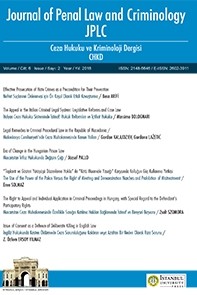Gravity of the Act as an Effective Tool for Diffe-rentiation between Traffic Crimes and Offences or Just Another Stumbling Stone
.
Anahtar Kelimeler:
right to punish, criminality, categorisation, differentiation, crimes, offences, road safety, incriminations, conduct, effects, dual crimina-lity, legality principle, functionality
Gravity of the Act as an Effective Tool for Diffe-rentiation between Traffic Crimes and Offences or Just Another Stumbling Stone
After refreshing basic knowledge about the states right to pu-nish and to define when and how it will be the particular conduct punished and then through well known different approaches in the delimination between crimes and offences, our efforts in this article are focused on question, how to establish prior mentioned distinc-tion in cases where the road safety is on the line. Namely if the we-ight of some individual act is by prevailing quantitative delimitation its main distinctive sign, there must be taken into account not only its outcome, but also perpetrators conduct, which could be more or less risky. On the one hand this simple fact helps us in deliminating serious acts from less serious, but on the other, when the conduct and its outcome are not proportionate, takes us to a new areas, where the prior delimination becomes quiet uncertain. In such cases it is necessary to seek additional criteria by which to get a scale with most and less serious traffic delicts and thereby separation between traffic delict as a crime and offence. Without that tresspasing the prohibition of dual criminality is difficult to prevent. Designing two major crimes against the road safety in Penal code, slovenian legis-lator did not go down this path . Criminalization of the first act by weight of the effects and the second by weight of conduct, gravity of the particular act as a whole becomes unclear and internally un-consistent, while in the light of discussed delimination demands special judicial attention toward dual criminality prohibition, which could be obstructed.
Keywords:
right to punish, criminality, categorisation, differentiation, crimes, offences, road safety, incriminations, conduct, effects, dual crimina-lity, legality principle, functionality,
___
- Ambrož M./Jenull H, Kazenski zakonik, Razširjena uvodna pojasnila (Penal Code Expanded Introductory Explanati-ons), GV Založba 2012, p. 537.
- Bonačić M./Rašo M., Obiležja prekšajnog prekršajnog prava i sudovanja, aktualna pitanja i prioriteti de lege ferenda (Ele-ments of Law of Offences and its Proceedings, Actual Ques-tions and Priorities de lege ferenda, Hrvatski ljetopis za kaz-neno pravo i praksu (Croatian Yearbook for Penal Law and Practice), p. 439-472.
- Dežman Z. in Korošec D. et. al. Cestnoprometno kazensko pravo (Roadtraffic Penal Law), GV Založba, Ljubljana 2013, p. 334.
- Karakaš A., Vprašanje upravičenosti gospodarskih pres-topkov kot samostojne kategorije kaznivih ravnanj in prob-lem prekrškov z vidika načela zakonitosti (The Question of Justificatication of Economical Contraventions as an Auto-nomous Category of Criminal Acts and Problem of Offences from the Standpoint of Legality Principle Pravnik 6-8/1996, p. 389-401.
- Novoselec P., Opći dio Kaznenog prava (General Part of Pe-nal Law), Sveučilište u Zagrebu, Zagreb 2004, p. 513.
- Pitamic L., Država (The State), Cankarjeva založba, Ljublja-na 1996 (1927), p.514.
- Šelih A. Prekrški v primerjalno pravni perspektivi (Offences in Legal Comparative Perpective), Zbornik 1. dnevi prekrškovnega prava, GV Založba, Ljubljana 2006, p. 173-180.
- Selinšek L., Kazensko pravo splošni del in osnove posebnega dela (Penal Law, General Part and Basics of the Special Part), GV Založba, Ljubljana 2007, p. 460.
- Summers R.S., Form and Function in a Legal Sistem, A Gene-ral Study, Cambridge University Press, Cambridge, 2006, p.422.
- ISSN: 2148-6646
- Yayın Aralığı: Yılda 2 Sayı
- Başlangıç: 2014
- Yayıncı: Adem Sözüer/ Rahime ERBAŞ
Sayıdaki Diğer Makaleler
Driving under the Influence of Alcohol and Drugs
Alman Federal Embriyonun Korunması Hakkında Kanun
Criminal Offence of »Causing a Traffic Accident through Negligence« in Slovenian Criminal Co-de
Tortious Liability of a Driver in Road Traffic
Injury and Death Offences in Traffic Accidents Caused by Criminal Negligence
The Institute, Called Liability for Graver Con-sequences in Slovenian Criminal Law on Road Traffic
